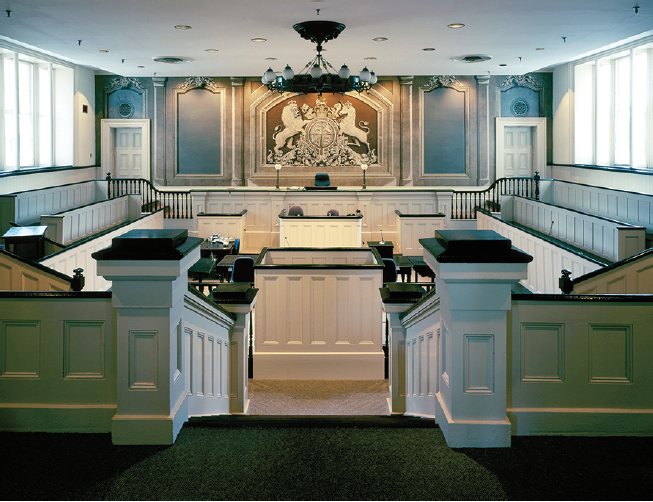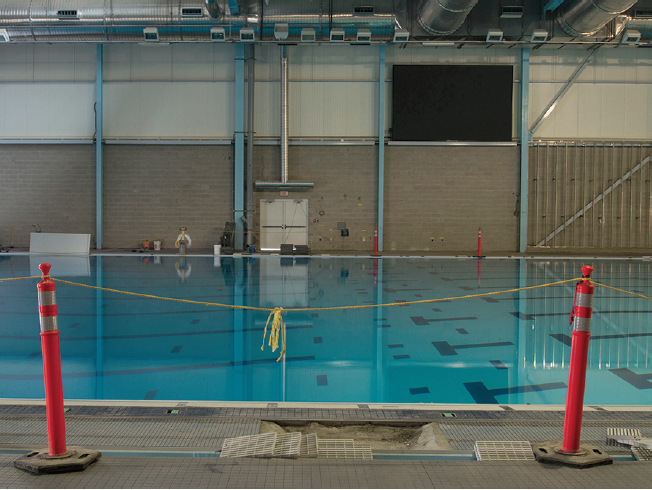Brenda Francis Pelkey
Brenda Francis Pelkey’s touring retrospective exhibition, which originated at the Art Gallery of Windsor and was recently on view at the Mount Saint Vincent University Art Gallery in Halifax, with more stops to come, is a thoughtful, definitive and occasionally surprising project that sheds new light on a photographer who, based on the evidence of this retrospective, should be better known by Canadians.
The exhibition traces the evolution of her photography, which has followed an arc from documentary, through photo-text work heavily infused with feminist and postmodern ideas, back to documentary— documents bearing the marks of her sustained thinking about images, places and the web of social interactions and preconceptions that infuse sites.

Brenda Francis Pelkey, Court, Cobourg, 2005, printed large format, 2016, inkjet on bonded aluminum, 1016 x 165 cm. Collection of the artist.
The earliest work in the exhibition, Foundry, is the transition work from her early career as a documentary photographer. Taken over a three-year period from 1987 to 1989, these photographs of an industrial foundry and its workers were initially a commission by the foundry’s owner and evolved into a larger project concentrating on portraits of the foundrymen and their day-to-day labours.
Pelkey’s interest in documenting little-seen spaces continued with “… The Great Effect of Imagination on the World,” a series of photographs of private homes with eccentric decorations: castles, grottoes, architectural replicas, etc., constructed mostly by retired working-class people in Saskatoon. The series also introduced two technical approaches that would prove to become mainstays in her photographic style: photography at night, using movie lights for illumination; and piecing together multiple prints in a disjointed manner that made the contingency of the composition a central, unavoidable fact for the viewer.
Throughout the ’90s Pelkey’s projects incorporated text, often poetic story fragments that evoked memory and suggested fictions, nowhere more effectively than in the remarkable series of photographs taken in Nova Scotia at Harvre Boucher, a town where she had lived as a young woman. The linked series “dreams of life and death” and “Memento Mori,” which began in 1994 and were completed in 1996, remain among her most powerful works to this day.

Pool with Stanchions, 2012–13, printed large format, 2015–16, inkjet on bonded aluminum, 76 x 110 cm. Collection of the artist.
The most recent work in the show, an ongoing documentary project photographing the new aquatic centre that is being built in Windsor, began in 2013. Pelkey’s photographs of the site, taken at night or in the very early morning when it is devoid of other human presence, are minimalist, focusing on the geometries of the architecture, the construction materials, the random placement of tools and fixtures in the ebb and flux of a construction project. Compositions consisting of lines, masses and blocks of colour, they fascinate with the way they suggest aesthetic intention, while we know all along that any intention present has to do with the logic of the building itself, of the jobs at hand, an intention whose finished statement will bear little or no visual relationship to these statements documenting the process as it unfolds.
The nine bodies of work in “Territories” present a sustained photographic investigation of place, memory and the social construction of sites, a strong body of work that demands, and will certainly earn, wider attention. ❚
“Territories” was exhibited at Mount Saint Vincent University Art Gallery, Halifax, from April 22 to July 9, 2017. It was on exhibition at the Art Gallery of Windsor, Windsor, ON, from October 22, 2016, to January 22, 2017, and will be exhibited at the Art Gallery of Peterborough, Peterborough, ON, from September 30, 2017, to January 7, 2018.
Ray Cronin is a writer and curator living in Halifax, Nova Scotia, and the founding curator of the Sobey Art Award. He is a frequent contributor to exhibition catalogues, magazines and books about Canadian art.

